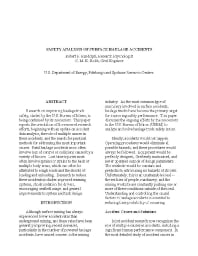Mining Publication: Safety Analysis of Surface Haulage Accidents
Original creation date: January 1996
Authors: RF Randolph, CM Boldt
NIOSHTIC2 Number: 20025241
Proc 27th Annual Institute on Mining Health, Safety and Research. Blacksburg, VA: August 26-28, 1996. Bockosh GR, Langton J, Karmis M, eds., Virginia Polytechnic Institute and State University, 1996 Jan; :29-38
Research on improving haulage truck safety, started by the U.S. Bureau of Mines, is being continued by its successors. This paper reports the orientation of the renewed research efforts, beginning with an update on accident data analysis, the role of multiple causes in these accidents, and the search for practical methods for addressing the most important causes. Fatal haulage accidents most often involve loss of control or collisions caused by a variety of factors. Lost-time injuries most often involve sprains or strains to the back or multiple body areas, which can often be attributed to rough roads and the shocks of loading and unloading. Research to reduce these accidents includes improved warning systems, shock isolation for drivers, encouraging seatbelt usage, and general improvements to system and task design.

NIOSHTIC2 Number: 20025241
Proc 27th Annual Institute on Mining Health, Safety and Research. Blacksburg, VA: August 26-28, 1996. Bockosh GR, Langton J, Karmis M, eds., Virginia Polytechnic Institute and State University, 1996 Jan; :29-38
- An Analysis and Prevention of Flyrock Accidents in Surface Blasting Operations
- Analysis of Mine Fires for All U.S. Underground and Surface Coal Mining Categories: 1990-1999
- Analysis of Multiple Seam Stability
- Characteristics of Fugitive Dust Generated from Unpaved Mine Haulage Roads
- Design of Surface Mine Haulage Roads - a Manual
- Haulage Truck Dump Site Safety: An Examination of Reported Injuries
- Preventing Collisions Involving Surface Mining Equipment: A GPS-based Approach
- Task Analysis
- Technology News 502 - A New Training Video for Aggregate Operators: Aggregate Training for the Safety Impaired
- Technology News 536 - NIOSH Develops New Software to Analyze and Reduce Noise Exposure